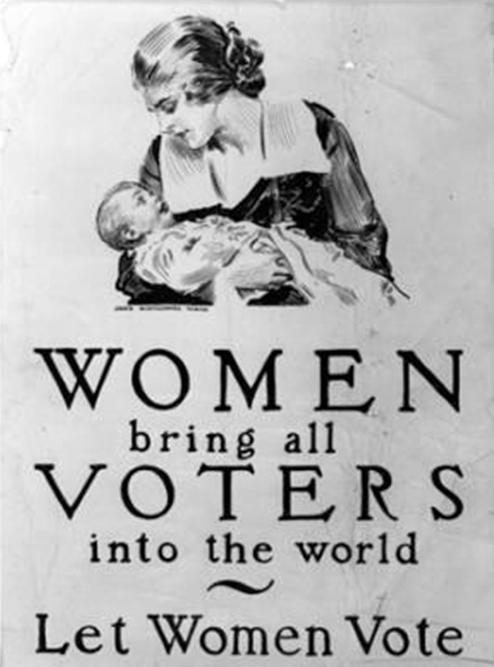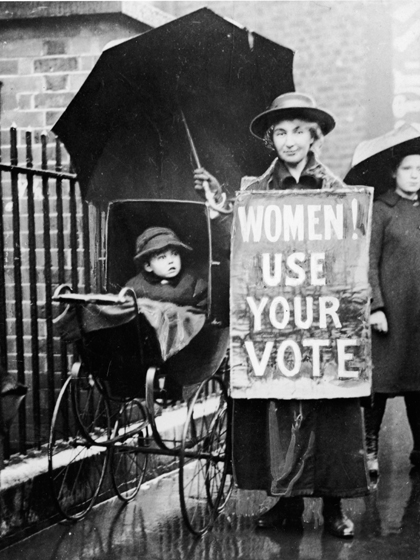 On Election Day in 1920, millions of American women exercised their right to vote for the first time. It took activists and reformers nearly 100 years to win that right, and the campaign was not easy: Disagreements over strategy threatened to cripple the movement more than once. But on August 26, 1920, the 19th Amendment to the Constitution was finally ratified, enfranchising all American women and declaring for the first time that they, like men, deserve all the rights and responsibilities of citizenship.
On Election Day in 1920, millions of American women exercised their right to vote for the first time. It took activists and reformers nearly 100 years to win that right, and the campaign was not easy: Disagreements over strategy threatened to cripple the movement more than once. But on August 26, 1920, the 19th Amendment to the Constitution was finally ratified, enfranchising all American women and declaring for the first time that they, like men, deserve all the rights and responsibilities of citizenship. ![]()
May

The Abolitionists and the Suffragists
The campaign for women’s suffrage began in earnest in the decades before the Civil War. During the 1820s and 30s, most states had extended the franchise to all white men, regardless of how much money or property they had. At the same time, all sorts of reform groups were proliferating across the United States–temperance clubs, religious movements and moral-reform societies, anti-slavery organizations–and in many of these, women played a prominent role. Meanwhile, many American women were beginning to chafe against what historians have called the “Cult of True Womanhood”: that is, the idea that the only “true” woman was a pious, submissive wife and mother concerned exclusively with home and family. Put together, all of these contributed to a new way of thinking about what it meant to be a woman and a citizen in the United States.
In 1848, a group of abolitionist activists–mostly women, but some men–gathered in Seneca Falls, New York to discuss the problem of women’s rights. (They were invited there by the reformers Elizabeth Cady Stanton and Lucretia Mott.) Most of the delegates agreed: American women were autonomous individuals who deserved their own political identities. “We hold these truths to be self-evident,” proclaimed the Declaration of Sentiments that the delegates produced, “that all men and women are created equal, that they are endowed by their creator with certain inalienable rights, that among these are life, liberty, and the pursuit of happiness.” What this meant, among other things, was that they believed women should have the right to vote.
“This Hour Belongs to the Negro”
During the 1850s, the women’s rights movement gathered steam, but lost momentum when the Civil War began. Almost immediately after the war ended, the 14th and 15th Amendments to the Constitution raised familiar questions of suffrage and citizenship. (The 14th Amendment, ratified in 1868, extends the Constitution’s protection to all citizens–and defines “citizens” as “male”; the 15th, ratified in 1870, guarantees black men the right to vote.)
Some woman-suffrage advocates, among them Stanton and Susan B. Anthony, believed that this was their chance to push lawmakers for truly universal suffrage. As a result, they refused to support the 15th Amendment and even allied with racist Southerners who argued that white women’s votes could be used to neutralize those cast by African-Americans. In 1869, this faction formed a group called the National Woman Suffrage Association and began to fight for a universal-suffrage amendment to the federal Constitution.
Others argued that it was unfair to endanger black enfranchisement by tying it to the markedly less popular campaign for female suffrage. This pro-15th-Amendment faction formed a group called the American Woman Suffrage Association and fought for the franchise on a state-by-state basis.
The Progressive Campaign for Suffrage
This animosity eventually faded, and in 1890 the two groups merged to form the National American Woman Suffrage Association. (Elizabeth Cady Stanton was the organization’s first president.) By then, the suffragists’ approach had changed. Instead of arguing that women deserved the same rights and responsibilities as men because women and men were “created equal,” the new generation of activists argued that women deserved the vote because they were different from men. They could make their domesticity into a political virtue, using the franchise to create a purer, more moral “maternal commonwealth.”
This argument served many political agendas: Temperance advocates, for instance, wanted women to have the vote because they thought it would mobilize an enormous voting bloc on behalf of their cause, and many middle-class white people were swayed once again by the argument that the enfranchisement of white women would “ensure immediate and durable white supremacy, honestly attained.”
Winning the Vote at Last
Starting in 1910, some states in the West began to extend the vote to women for the first time in almost 20 years. (Idaho and Utah had given women the right to vote at the end of the 19th century.) Still, the more established Southern and Eastern states resisted. In 1916, NAWSA president Carrie Chapman Catt unveiled what she called a “Winning Plan” to get the vote at last: a blitz campaign that mobilized state and local suffrage organizations all over the country, with special focus on those recalcitrant regions. (Meanwhile, a splinter group called the National Women’s Party focused on more radical, militant tactics–hunger strikes and White House pickets, for instance–aimed at winning dramatic publicity for their cause.)
World War I slowed the suffragists’ campaign but helped them advance their argument nonetheless: Women’s work on behalf of the war effort, activists pointed out, proved that they were just as patriotic and deserving of citizenship as men, and on August 26, 1920, the 19th Amendment to the Constitution was finally ratified.
Categories
- Algebra (5)
- Apps (52)
- Articles (11)
- Asian History (4)
- Asian History Heritage (13)
- Asian History Heritage Articles (8)
- Asian History Heritage Prayer (1)
- Asian History Heritage Spotlight (9)
- Band (3)
- Biology (11)
- Black History Heritage (39)
- Black History Heritage Articles (17)
- Black History Heritage Links (6)
- Black History Heritage Prayers (12)
- Black History Heritage Spotlight (16)
- Calculus (5)
- Career Counseling (1)
- Chemistry (10)
- Chorus (3)
- Computer Science (3)
- Dance (2)
- Economics (11)
- English (11)
- English Studies (3)
- Environmental Science (12)
- Ethics & Values (13)
- Faith & Culture (12)
- Faith & Culture Articles (7)
- Faith & Culture Prayers (4)
- Faith & Culture Spotlight (4)
- Faith & Religion (9)
- FAQ (3)
- FAQ Gradebook (3)
- French (4)
- Gay, Lesbian, and Transgender (17)
- Gay, Lesbian, and Transgender – Articles (7)
- Gay, Lesbian, and Transgender – Prayers (3)
- Gay, Lesbian, and Transgender – Spotlight (10)
- Geography/Epistemology (6)
- Geometry (4)
- Health (6)
- Inclusive Curriculum at Saint Mary’s (1)
- International Languages (13)
- Irish History & European Cultures (18)
- Irish History & European Cultures – Articles (7)
- Irish History & European Cultures – Prayers (6)
- Irish History & European Cultures – Spotlight (7)
- Islamic History (4)
- Latino & Hispanic History & Heritage (25)
- Latino & Hispanic History & Heritage Articles (13)
- Latino & Hispanic History & Heritage Prayers (5)
- Latino & Hispanic History & Heritage Spotlight (17)
- Learning Management (26)
- Lectures (2)
- Literature (3)
- Marine Biology (9)
- Mathematics (15)
- Multimedia (5)
- Physical Education (2)
- Physical Education & Health (16)
- Physics (10)
- Physiology (8)
- Poetry (3)
- Psychology (10)
- Public Policy (12)
- Register to Vote! (10)
- Register to Vote! – Articles (5)
- Register to Vote! – Links (3)
- Register to Vote! – Prayers (1)
- Register to Vote! – Spotlight (2)
- Religious Studies (21)
- Science (23)
- Scripture (9)
- Senior Project (1)
- Social Justice (13)
- Social Studies (25)
- Spanish (4)
- Sports Medicine (4)
- Statistics (5)
- Student Committee (3)
- Student Committee – 2015-2016 (2)
- Technology Use Guides (8)
- Theater Arts (6)
- Trigonometry (4)
- Uncategorized (6)
- US Government (9)
- US History (10)
- Videos (6)
- Visual & Performing Arts (15)
- Visual Arts (6)
- Women History – Articles (3)
- Women History – Prayers (2)
- Women History – Spotlight (3)
- Womens History (8)
- World History (8)
- World Religions (9)
Post Calendar
| M | T | W | T | F | S | S |
|---|---|---|---|---|---|---|
| 1 | 2 | 3 | 4 | 5 | 6 | |
| 7 | 8 | 9 | 10 | 11 | 12 | 13 |
| 14 | 15 | 16 | 17 | 18 | 19 | 20 |
| 21 | 22 | 23 | 24 | 25 | 26 | 27 |
| 28 | 29 | 30 | ||||
Categories
Archives
- March 2020 (3)
- October 2017 (3)
- September 2017 (3)
- August 2017 (2)
- April 2017 (3)
- February 2017 (13)
- September 2016 (1)
- August 2016 (1)
- May 2016 (28)
- April 2016 (9)
- March 2016 (3)
- February 2016 (94)
- January 2015 (8)
- December 2014 (12)
- September 2014 (1)
- November 2013 (1)
- October 2013 (1)
- May 2013 (2)
- April 2013 (23)
- March 2013 (14)
- February 2013 (13)
- October 2012 (1)
- September 2012 (2)
- January 2012 (1)
Recent Posts
- Distance Learning Resources March 18, 2020
- Visualizing the History of Pandemics March 15, 2020
- Visualizing the History of the World March 15, 2020
- America Georgine Ferrera October 4, 2017
- Sophie Cruz October 3, 2017

